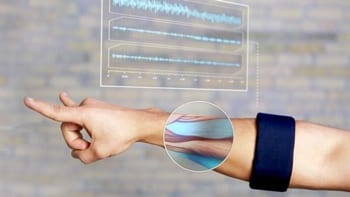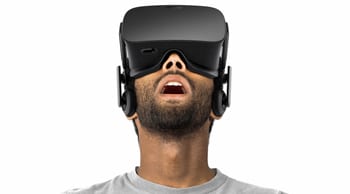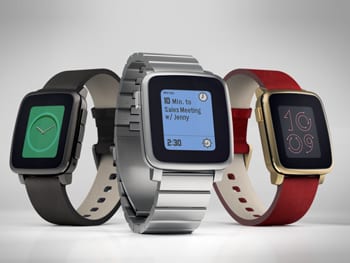The 4 New Engineering & Design Technologies Changing How We Create

It seems that in the last few years, society has introduced more new ways to interact with technology than ever before. The origin of the computer keyboard can be traced back to the invention of the typewriter by Christopher Latham Sholes in 1868. This was followed by the computer mouse in 1964, and the first touchscreen technology in 1965. Since then, the launch of new interfaces have grown exponentially.
In the 21st century we are seeing several new consumer level technologies in the form of biometric gesture control, holographic interactions, virtual reality (VR), and wearable technologies. This large growth in interface design options have led to intuitive new ways to design, engineer, and model both virtual and physical products. There has clearly been a massive shift in the interactivity with technology, each new iteration more intuitive than the last. Although there are a wide variety of new technologies, I will highlight some of the top new interactive technologies that are helping to make design and engineering easier and paving the way for the products of the future.
Thalmic Labs Myo Wearable Gesture Control
 This Kitchener-Waterloo, Ontario organization has developed an armband that senses the movement of the arm, and the user’s arm muscles and translates these into customizable computer inputs. The Myo is marketed to be able to control presentations, annotating slides, point and zoom, and map keystrokes to gestures that you make with your arm and hands, however its full capabilities are vast. The Myo also integrates with software for 3D modelling for engineers, architects, designers and can also be used alongside holographic or virtual reality headsets to provide a more immersive design environment. The sensitivity and natural movement makes Thalmic Labs’ Myo a powerful tool for CAD designers, as well as many other applications from medical to gaming.
This Kitchener-Waterloo, Ontario organization has developed an armband that senses the movement of the arm, and the user’s arm muscles and translates these into customizable computer inputs. The Myo is marketed to be able to control presentations, annotating slides, point and zoom, and map keystrokes to gestures that you make with your arm and hands, however its full capabilities are vast. The Myo also integrates with software for 3D modelling for engineers, architects, designers and can also be used alongside holographic or virtual reality headsets to provide a more immersive design environment. The sensitivity and natural movement makes Thalmic Labs’ Myo a powerful tool for CAD designers, as well as many other applications from medical to gaming.
Oculus Rift Virtual Reality Headset
 Oculus Rift has generated a lot of buzz amongst the gaming community, but its application goes far beyond PC and Xbox gaming. With an initial focus on immersive video games, this virtual reality headset supports a wide field of view and allows the user to rotate their head and look around the virtual environment as if they were inside it. Previous attempts lacked the responsiveness, high definition, and motion sensitivity that makes Oculus so successful. Oculus’ started as a Kickstarter project that generated $2.4M and has since proved itself as a market leader in the virtual reality sector, which consequently led to its acquisition by Facebook for $400M and 23.1M Facebook shares.
Oculus Rift has generated a lot of buzz amongst the gaming community, but its application goes far beyond PC and Xbox gaming. With an initial focus on immersive video games, this virtual reality headset supports a wide field of view and allows the user to rotate their head and look around the virtual environment as if they were inside it. Previous attempts lacked the responsiveness, high definition, and motion sensitivity that makes Oculus so successful. Oculus’ started as a Kickstarter project that generated $2.4M and has since proved itself as a market leader in the virtual reality sector, which consequently led to its acquisition by Facebook for $400M and 23.1M Facebook shares.
Although gaming is currently Oculus’ primary target market, proven with their Microsoft partnership in bundling an Xbox 360 controller with every unit, Oculus also offers their own proprietary Oculus Touch controller and offers other virtual reality experiences. For example, Facebook hopes to capitalize on virtual reality as a way to share experiences. VR has also been introduced into the film and video industry as a more interactive viewing option.
Oculus continues to be a market leader in this space, however the sector is already seeing many competitors enter the ring, including Sony, HTC, and Microsoft-owned Razer. In fact, Google has created Google Cardboard, which is foldable cardboard that wraps around your Android smartphone to create an inexpensive VR headset. VR is proving itself as a viable media consumption and creation tool and will be an important interface for engineers to conceptualize new designs.
Microsoft Hololens Holographic Display
 This holographic headwear looks like something out of a sci-fi movie; however the tech behind it is proven. The visor acts as a heads-up display (HUD) that overlays holographic images amongst the user’s field of view. The result is a very immersive and integrated user interface that can meld the real world and digital content.
This holographic headwear looks like something out of a sci-fi movie; however the tech behind it is proven. The visor acts as a heads-up display (HUD) that overlays holographic images amongst the user’s field of view. The result is a very immersive and integrated user interface that can meld the real world and digital content.
For example, a user can place holographic images on their walls, walk around models, and use their hands to interact and modify 3D models. Although the first iteration of this device has a limited field of view, the hardware has positioned itself primarily as an engineering design tool and excitement from the development community is a good indication that Hololens will be a powerful tool to engineers, software developers, and designers. Check out an example of creating with Hololens in this demo.
Pebble and the Rise of Wearables
 Pebble started as one of the most popular Kickstarter campaigns of all time; proving the power of crowdfunding. This watch was one of the first affordable, practical wearable devices created for consumers. Its e-ink display acted as the device’s watch face and provided excellent battery life and versatility while syncing and sharing information between a smartphone and the watch. Although the Pebble is not a dedicated engineering or design tool, it is a pioneer in wearable technologies. Our society is continuing to see a large push towards wearables and Pebble is a large contributor to the development of this sector, inspiring larger corporations to develop their own versions, including the Apple Watch and Android Wear devices. As the competition increases, we will start to see wearable technology become more ingrained in fashion, design, engineering, gaming, healthcare, and nearly all other industries; Pebble is partially responsible.
Pebble started as one of the most popular Kickstarter campaigns of all time; proving the power of crowdfunding. This watch was one of the first affordable, practical wearable devices created for consumers. Its e-ink display acted as the device’s watch face and provided excellent battery life and versatility while syncing and sharing information between a smartphone and the watch. Although the Pebble is not a dedicated engineering or design tool, it is a pioneer in wearable technologies. Our society is continuing to see a large push towards wearables and Pebble is a large contributor to the development of this sector, inspiring larger corporations to develop their own versions, including the Apple Watch and Android Wear devices. As the competition increases, we will start to see wearable technology become more ingrained in fashion, design, engineering, gaming, healthcare, and nearly all other industries; Pebble is partially responsible.
Are you looking to commercialize the next revolutionary technology? Small business funding can help!
Canadian businesses dedicated to creating innovative new technologies can benefit from a wide variety of research and development funding. Canadian government funding exists on both the provincial and federal levels to cover research labour costs, subcontractor expenses, materials, supplies, post-secondary collaborative projects, as well as other project related expenses. Mentor Works is holding free events to educate businesses on research grants; please register for an upcoming research grants webinar to find out what is available to support your innovative projects or give us a call directly at 1-888-599-3111.
